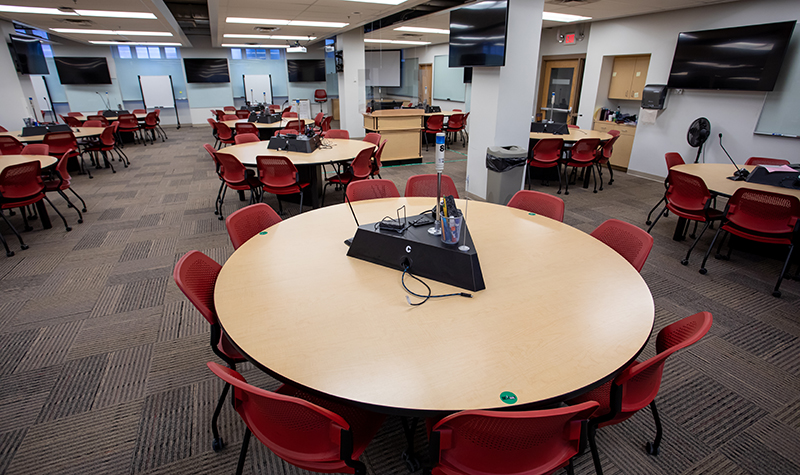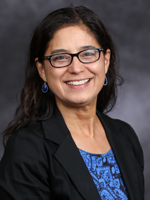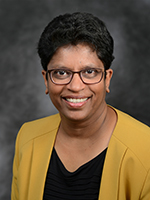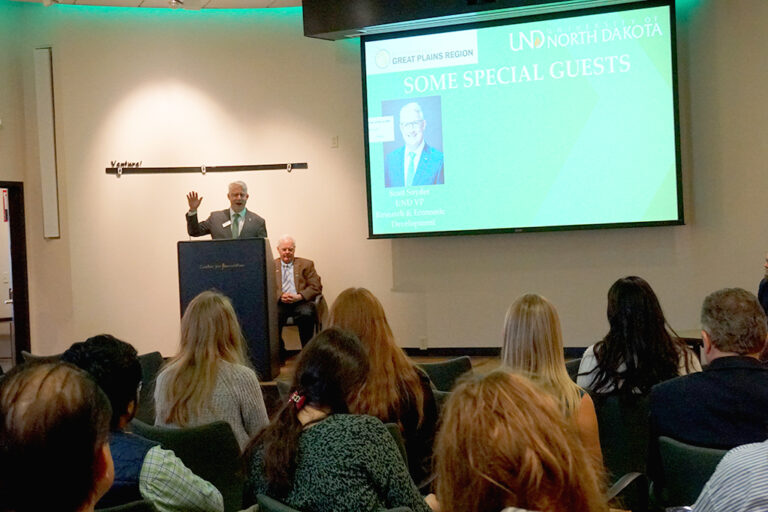Upgraded classrooms help UND deliver more effective instruction
Technology and flexible furnishings elevate classrooms for collaborative learning

Rows of wooden desks, all facing a writing board and stretching from wall to wall. In its essence, this is a conventional classroom; a layout that still permeates many schools and colleges and promotes passive learning.

“These are old-school style classrooms that encourage sage-on-the-stage pedagogy,” said Debbie Storrs, University of North Dakota interim provost and vice president of academic affairs.
Yet, in a modern, connected world, lecturing is no longer how students want to learn and how educators want to teach. Active learning shifts courses from being professor-led to being student-centric through in-class discussions of big ideas, data, and scholarly materials and team-based assignments, among other things.
“Research shows that students learn better when you actively engage them,” said Storrs. “And, we retain them at a higher rate.”
The power of collaborative learning
Collaborative learning helps students develop critical interpersonal skills to work in diverse teams – an experience that companies increasingly seek from new hires. “Every employer survey I’ve ever seen identifies the ability to work effectively with diverse teams as a really important skill set,” said Storrs.
To promote active and collaborative learning, UND incorporates high-impact assignments and projects in the curriculum, an effort that is a part of the institution’s Strategic Plan. Furthermore, supported by the Teaching Transformation and Development Academy (TTaDA), the University’s faculty has developed roughly 500 courses that heed the so-called high-flex model that encourages student participation both online and offline.
“In the high-flex model, students are able to work together on projects with the instructor, whether they’re in the classroom or not in the classroom, whether they’re Zooming in synchronously, or whether they’re asynchronously connecting later,” said Jeff Holm, vice provost for Online Education and Strategic Planning.

The role physical classrooms play in supporting collaborative learning
For such collaborative educational endeavors, however, the traditional classroom provides an ill-suited physical environment. Because of that, UND has been steadily updating classrooms and shared spaces with new furniture and enhanced technology. While dynamic seating arrangements (think a round table instead of a long desk, and chairs on wheels rather than secured to the floor) encourage students to work together, technology has especially risen in prominence when it comes to learning.

“The basic technology for any flexible learning space are the camera, the microphones, the digital writing tool, and the communication tools like Zoom,” said Chief Information Officer Madhavi Marasinghe.
For Robert Warren, marketing instructor at UND, having classrooms that can handle video conferencing through Zoom has allowed him to expand his courses and forge connections between his students and business professionals.
“Having classrooms that have the capacity to effectively use Zoom has been a great upgrade,” he said. “It’s helped in terms of getting industry speakers into the classroom. It’s fairly easy to get a local person to come in, unless they’re strapped for time. But it is nearly impossible to get someone outside of our region. Zoom has really taken that impediment away because they can just dial in.”
For a retail course, Warren recently brought in a speaker from Thailand to chat with students via Zoom about international marketing. Warren also organized a Zoom event with a Los Angeles-based manager at Sephora, the beauty company.
Having engaged in these Zoom-enabled learning opportunities, students can later apply their knowledge locally through internships and full-time jobs in North Dakota.
UND’s plan to upgrade classrooms
The coronavirus has accelerated UND’s timeline of overhauling classrooms on campus. To facilitate safe education physically and virtually amid COVID, Marasinghe’s team installed software and hardware in about 200 classrooms last summer. This is in addition to the updates that transpired prior to the pandemic.
The technological and physical upgrade to classrooms that made the Fall 2020 semester a success would not have been possible without the support of the state as well as the federal funds the University received through the CARES Act, the UND administrators interviewed for this article agreed.

As IT focused on the technology, UND instructors and professors spent the summer adjusting their courses so that students attending both in-person and online could learn effectively. TTaDA extensively supported these efforts, including complex redesigns of lab courses that are now using specialized simulators for experiments in a virtual world.
Although these more active and collaborative methods of teaching and learning began to form in higher education before COVID, to remain at the forefront of collaborative learning, UND envisions a strategic renovation of more learning spaces such as Merrifield Hall, where about 40 percent of all classes taught at the University take place.
“COVID gave us a taste of what future learning could look like, where students can learn from anywhere and still actively take part in the classroom.” Marasinghe said. “I doubt very much that higher education will go back to pre-COVID way of teaching and learning.”
UND faculty have worked hard to adjust to the new realities. “Our instructors have really shown during COVID that they are willing to embrace new ideas,” said Holm. “Flexible and high quality teaching space, engaged faculty, and technologies are essential components of student success.”


